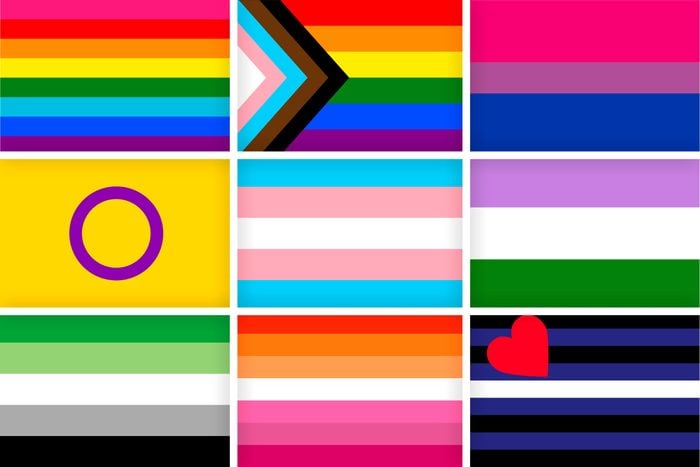
The diversity of the LGBTQ flags
When you think about symbols of the LGBTQ community, the rainbow-colored pride flag probably comes to mind right away. Its iconic stripes and hues can be found on flagpoles, front porches and lapel pins (not to mention plenty of other merchandise). But do you know the meaning behind the flag and how the rainbow became associated with gay rights? How about the fact that there have been several iterations of the rainbow flag as it’s evolved over time? Or that there’s actually a total of more than 30 different LGBTQ flags?
Far more than pieces of fabric, these LGBTQ flags tell the story of the individuals they represent, acting as tools of visibility in a society that does its best to ignore their basic human and civil rights. As you’re learning more about why it’s important to support LGBTQ-owned businesses and why Pride Month is in June, find out more about the meaning of some of the many LGBTQ flags as well. Here’s a brief introduction to 32 of them.
Get Reader’s Digest’s Read Up newsletter for more knowledge, holiday tips, fun facts, humor, cleaning, travel and tech all week long.

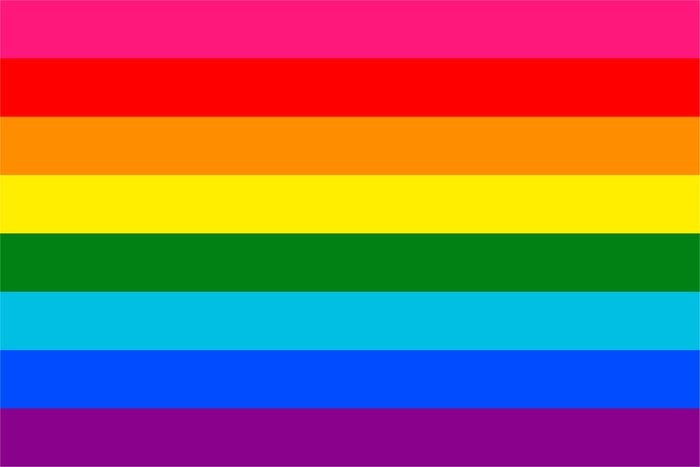
Gilbert Baker Pride Flag
Picture it: San Francisco, 1974. An artist, activist and openly gay military veteran named Gilbert Baker meets fellow activist, future politician and LGBTQ hero Harvey Milk. Three years later, Milk challenges Baker to create a symbol for the gay community, and the end product is the first rainbow LGBTQ flag. Each of the eight colors had a meaning:
- Pink: Sex
- Red: Life
- Orange: Healing
- Yellow: Sunlight
- Green: Nature
- Turquoise: Magic/Art
- Indigo: Serenity
- Violet: Spirit
Baker’s creation made its debut at the San Francisco Gay Freedom Day Parade on June 25, 1978—only a few months before Milk was assassinated.
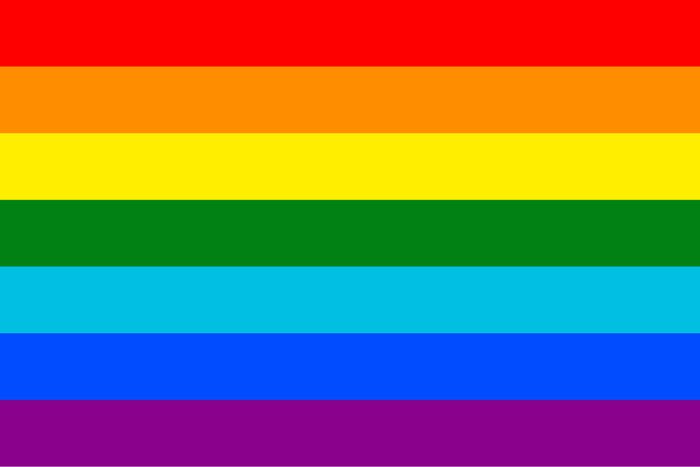
1978 Pride Flag
If this LGBTQ flag looks familiar, that’s because it’s Baker’s design with one modification: The hot pink stripe in his original 1977 flag was removed. Each color in the flag had a meaning, and hot pink stood for sex, but that’s not the reason for its disappearance. After Milk was murdered, the demand for the LGBTQ flag he commissioned increased, but both Baker and the Paramount Flag Company (which manufactured the flag) found that hot-pink fabric was hard to come by, so they ended up leaving it out.
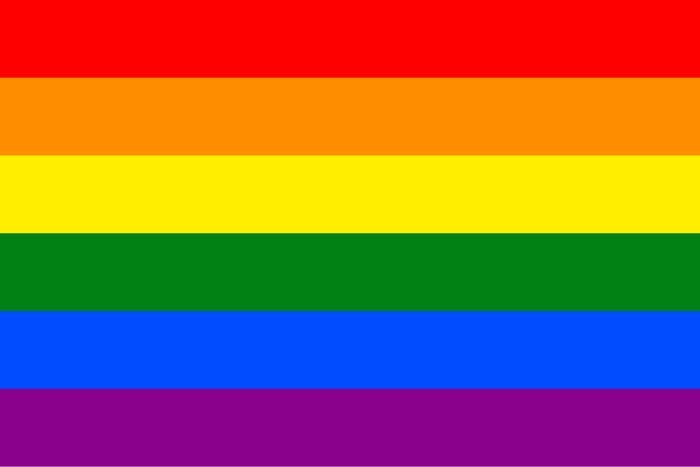
Traditional Gay Pride Flag
It would take another year before the original LGBTQ rainbow flag completed its evolution. After losing its pink stripe in 1978, the turquoise stripe would meet the same fate in 1979. There are two possible explanations: that the turquoise material, like the hot pink, was difficult to get, or that people preferred a flag with an even number of stripes. Either way, the change left us with the six colored stripes that adorned the flag when same-sex marriage was legalized in 2015—and still adorn it today.
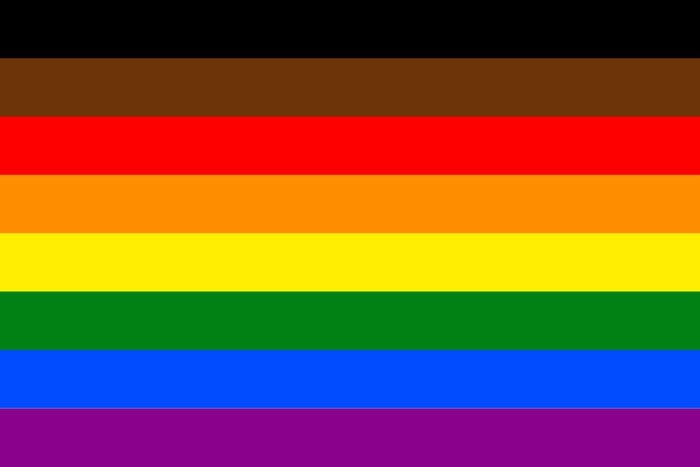
Philadelphia Pride Flag
The Philadelphia Pride Flag represents LGBTQ people of color, who historically were not always included in aspects of the mainstream gay rights movement. In addition to the original six stripes, this LGBTQ flag includes black and brown, symbolizing people of color. It was unveiled on June 8, 2017, at Philadelphia City Hall and was designed by a small Philly-based PR agency.
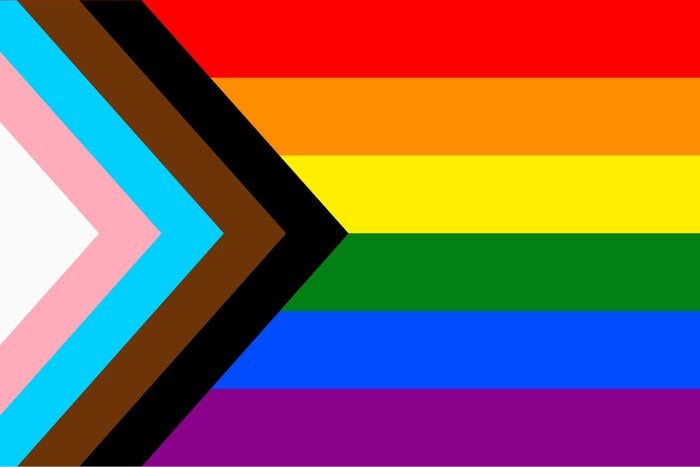
Progress Pride Flag
A year after the debut of the Philadelphia Pride Flag, Oregon-based designer Daniel Quasar introduced a reworked version of the more inclusive LGBTQ flag. “When the pride flag was recreated in the last year to include both black/brown stripes as well as the trans stripes included this year, I wanted to see if there could be more emphasis in the design of the flag to give it more meaning,” Quasar explained in a 2018 Kickstarter post raising money for the new flag.
The white, pink and light blue chevron design on the Progress Pride Flag reflects the colors of the Transgender Flag, while the brown and black stripes represent marginalized people of color. The black stripe has a dual meaning: It also honors those lost to HIV/AIDS and is a nod to the stigma surrounding those still living with HIV.
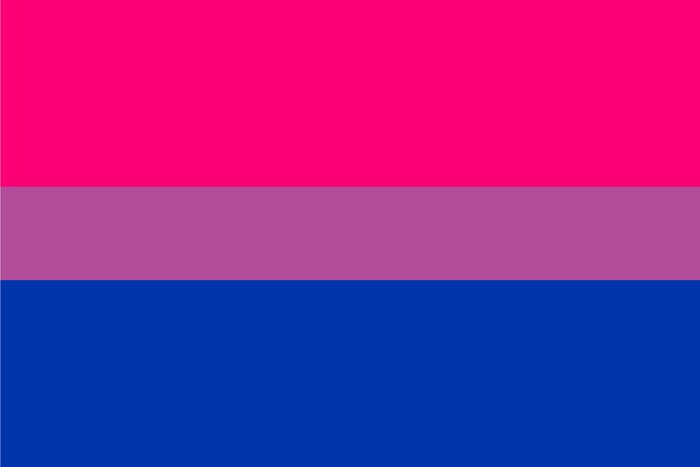
Bisexual Pride Flag
Florida-based LGBTQ activist Michael Page created the Bisexual Pride Flag in 1998 to increase the visibility of bisexual individuals—who are attracted to two genders—in both the LGBTQ community and society as a whole. The pink represents attraction to those of the same gender identity, while the blue stands for attraction to people who identify as a different gender. The purple stripe in the middle symbolizes attraction to two genders.
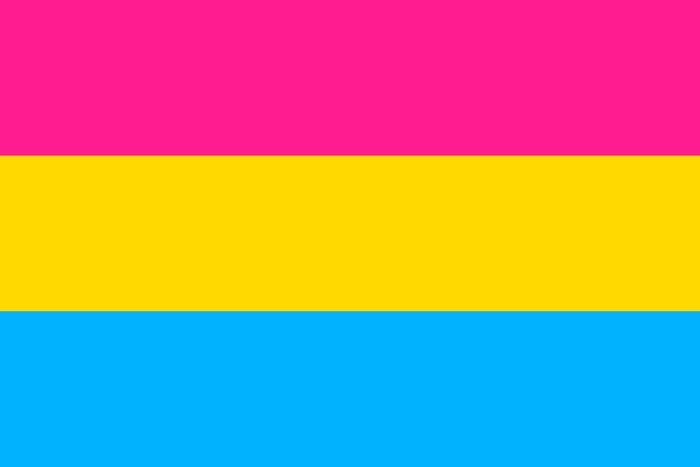
Pansexual Pride Flag
Pansexual folks—who are attracted to people regardless of their gender identity—got their own LGBTQ flag around 2010. It was created to both increase their overall visibility and help differentiate the group from bisexual individuals. Here, the pink represents attraction to people who identify as female, while the blue stands for attraction to those who identify as male. The yellow stripe in the middle represents attraction to those who identify as genderqueer, nonbinary, agender, androgynous or anyone who doesn’t identify on the male-female binary.
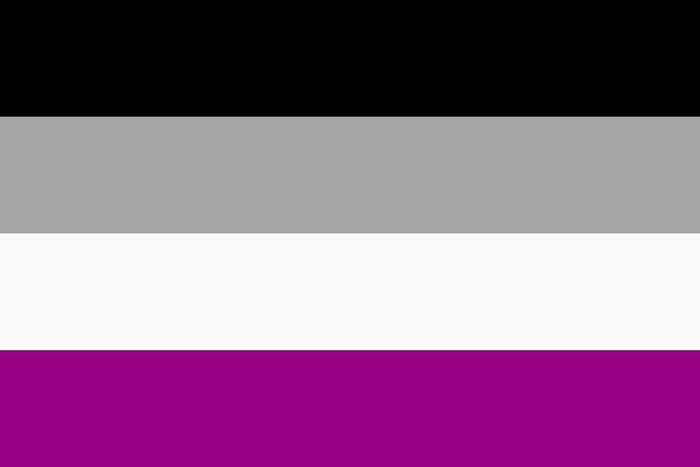
Asexual Pride Flag
Asexual individuals, who lack sexual attraction to all genders, got their own flag in 2010, following an Asexual Visibility and Education Network contest that challenged participants to create a flag for those who identify as asexual. Like the other LGBTQ flags, this one has a variety of colored stripes, each with its own meaning:
- Black: Asexuality
- Gray: Gray-asexuality and demisexuality
- White: Non-asexual partners and allies
- Purple: Community
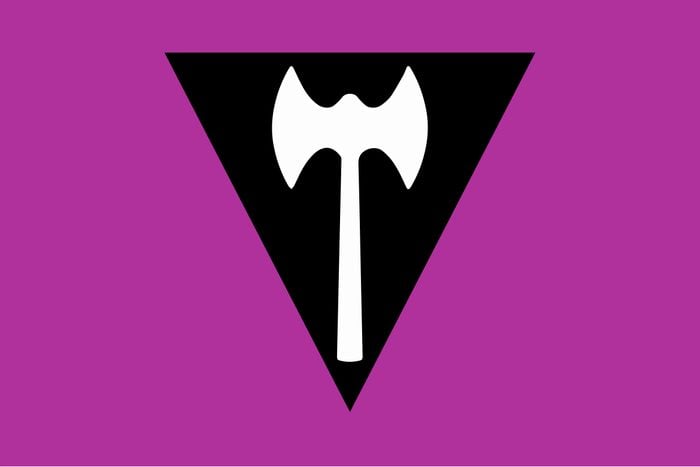
Labrys Lesbian Pride Flag
Although it’s not as well known as some of the other LGBTQ flags on the list, the Labrys Lesbian Pride Flag has been around since 1999. A labrys is the double-headed battle-ax seen on the flag, which can be traced back to matriarchal societies like the Minoans. Before making its way onto this flag, the labrys was seen as a symbol of empowerment for cisgender women, and it was adopted by some lesbian radical feminist groups in the 1970s. The purple in the flag represents cisgender women, while the black triangle symbolizes lesbians.
Though the LGBTQ community has come a long way since that first pride flag, there’s still progress to be made in ensuring equality and safety for all. Take, for instance, this story of a girl who was sent away by her family as a teen because she was gay. That happened in 2010, and it still happens across the country today—all the more reason for the fight for LGBTQ rights to continue.
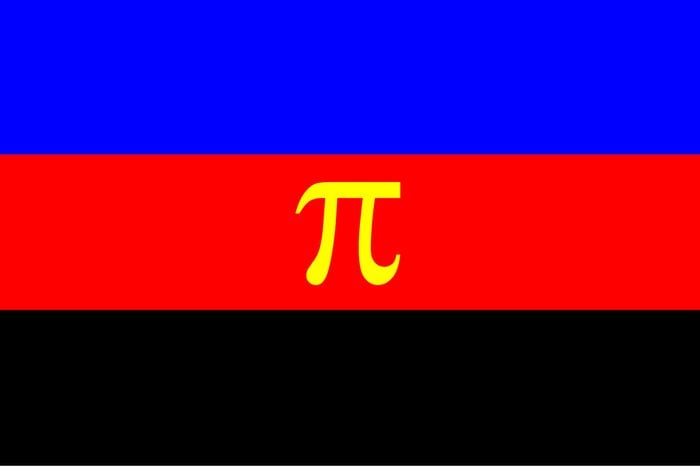
Polyamory Pride Flag
When Jim Evans created the Polyamory Pride Flag in 1995, he wanted it to be a symbol—and sign—for people who identify as polyamorous. The background of this LGBTQ flag has three stripes, each of which has a specific meaning: blue (the openness and honesty of all parties involved in the relationships), red (love and passion) and black (solidarity with those who must hide their polyamorous relationships from the outside world).
Evans placed a yellow pi symbol in the center of his flag, with the infinite number representing the infinite options for partners available to polyamorous people. An alternative version of this LGBTQ flag was also created in 2017, which replaces the pi symbol with the infinity hearts symbol.
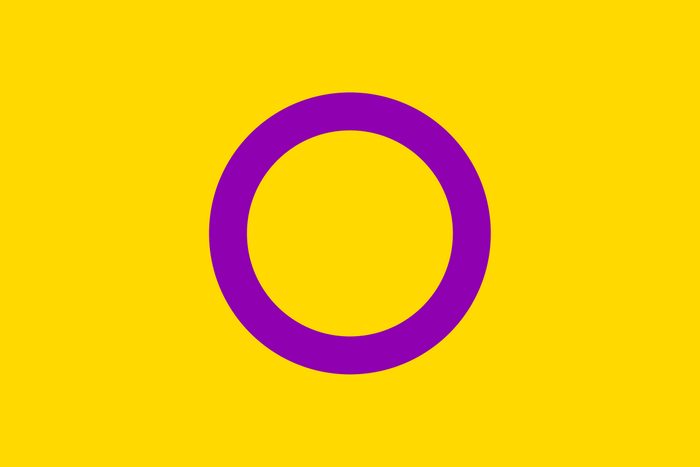
Intersex Pride Flag
The Intersex Pride Flag has been in existence since 2013, when Morgan Carpenter, then co-chair of Intersex Human Rights Australia, created and launched it. Unimpressed with some of the other symbols for intersex individuals, Carpenter wanted an LGBTQ flag “that is not derivative but is yet firmly grounded in meaning,” and he eventually landed on the version we know today, which features a purple circle on a yellow background. Carpenter used yellow and purple because the colors are seen as gender neutral, and the circle represents wholeness and completeness.
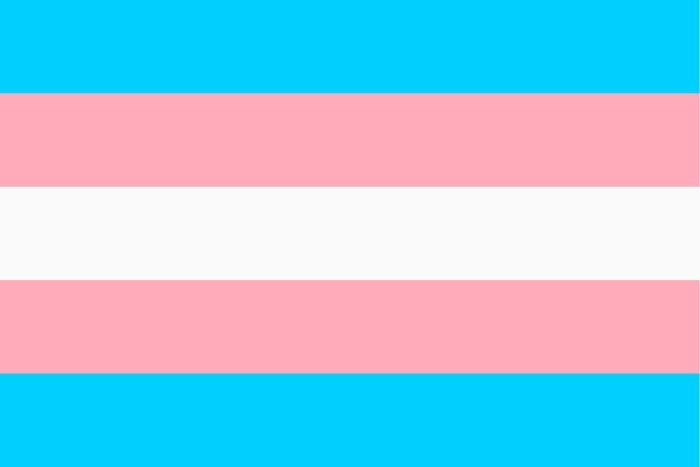
Transgender Pride Flag
The Transgender Pride Flag has been around since 1999, when an American transgender Navy veteran named Monica Helms created it. A year later, the flag made its debut at a pride parade in Phoenix. Light blue and pink are featured because they’re the traditional colors associated with baby boys and girls, respectively. The white represents those who are intersex, transitioning or see themselves as having a neutral or undefined gender.
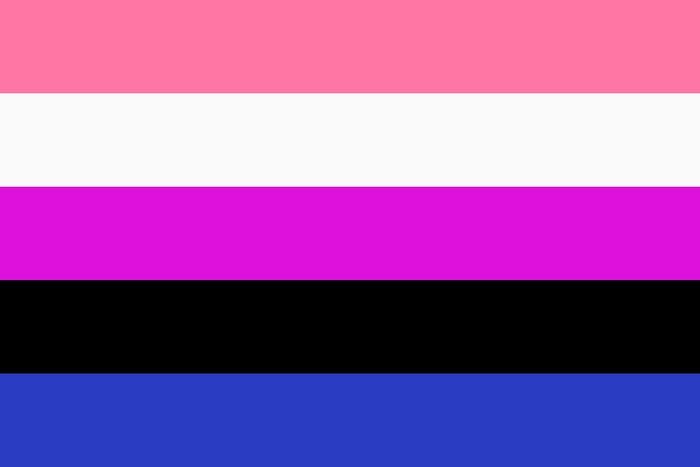
Genderfluid Pride Flag
JJ Poole created the Genderfluid Pride Flag in 2013 to represent folks whose gender identity and/or expression is fluid and may fluctuate at different times or in different circumstances. This LGBTQ flag has five horizontal stripes of different colors representing femininity (pink), lack of gender (white), a combination of both masculinity and femininity (purple), all genders anywhere on the spectrum (black) and masculinity (blue).
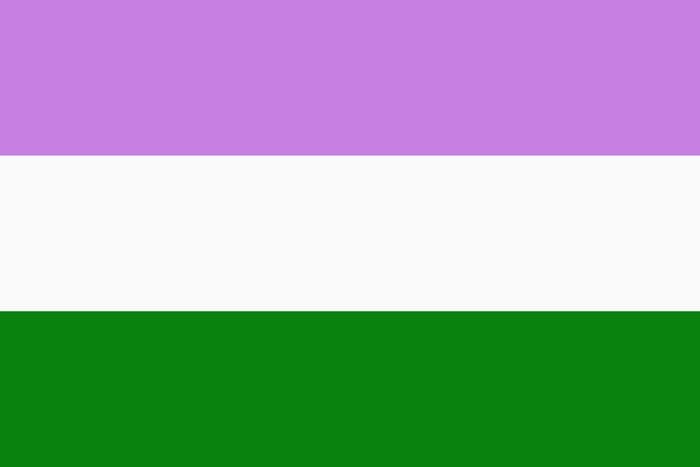
Genderqueer Pride Flag
Celebrate Pride Month with the Genderqueer Pride Flag, which writer and activist Marilyn Roxie designed in 2011 with input from the readers of the website Genderqueer Identities. As the combination of the traditionally masculine and feminine colors (blue and pink), lavender represents androgyny and other queer identities, while white stands for agender identity and green represents those whose identities are defined outside the binary.
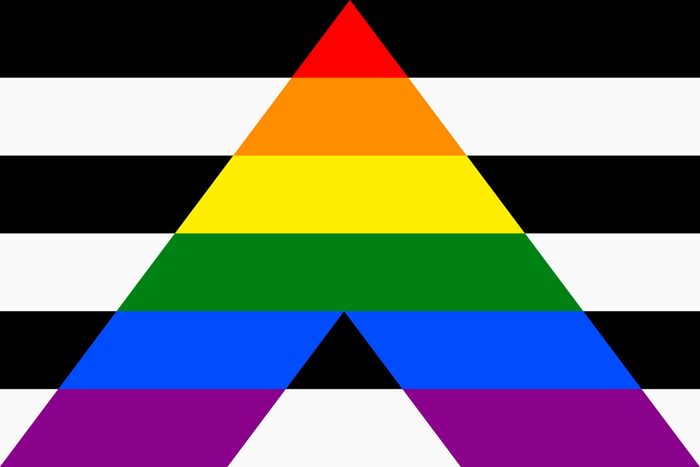
Ally Pride Flag
Although the precise origin of the Ally Pride Flag is unknown, it was created sometime in the late 2000s as a symbol of the heterosexual and/or cisgender people who actively support LGBTQ individuals. The “A” in the center of the flag stands for the word ally and features the six colors of the rainbow pride flag. The black-and-white stripes in the background represent heterosexual and/or cisgender people.
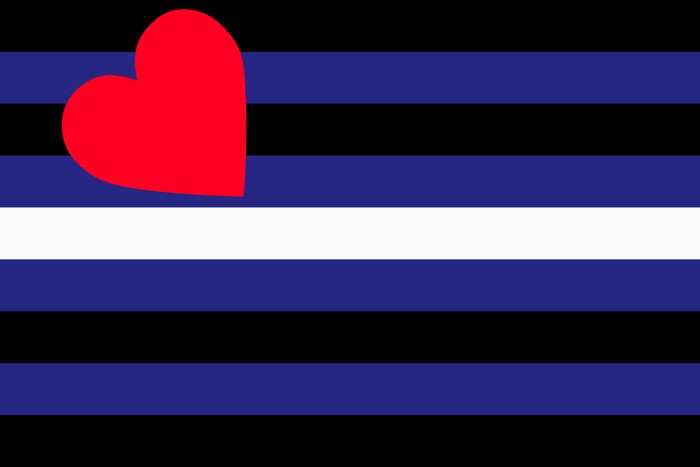
Leather Pride Flag
Though originally representative of members of the leather subculture, this LGBTQ flag has also been embraced by the wider BDSM and fetish community. Designed by Tony DeBlase for Chicago’s International Mr. Leather celebration in 1989 to mark the 20th anniversary of the Stonewall Riots, the symbol represents people involved with kink—including those who are heterosexual and/or cisgender. The flag itself is open to interpretation, composed of nine horizontal stripes alternating in color between black and blue, a white stripe in the middle and a red heart in the upper-left-hand corner. DeBlase indicated that he wanted to “leave it to the viewer to interpret the colors and symbols.”
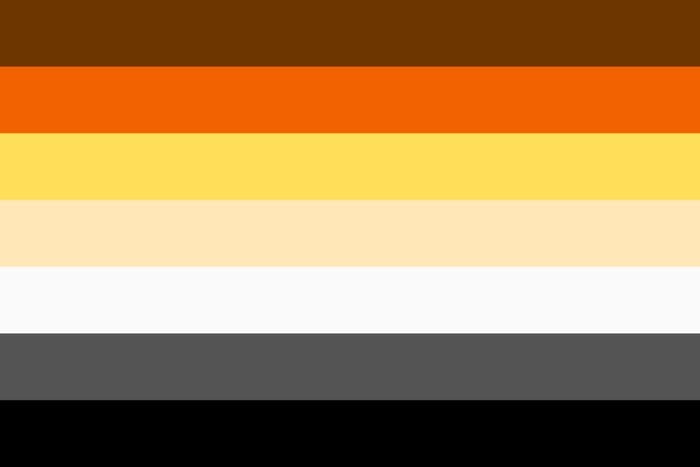
Bear Brotherhood Pride Flag
Members of the International Bear Brotherhood—comprised of gay men with a specific set of physical traits, including facial hair and a sturdy build—got their own flag in 1995. The dark brown, orange/rust, golden yellow, tan, white, gray and black stripes of the flag represent the fur colors of the animal the group is named after.
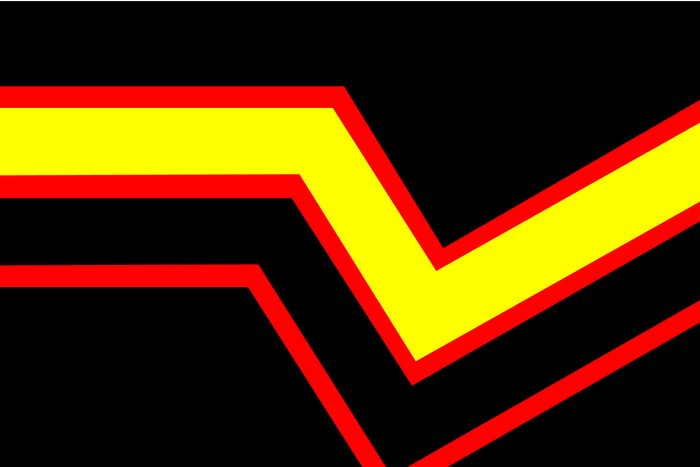
Rubber Pride Flag
The leather subculture wasn’t the only group to get its own flag in 1995. Members of the rubber and latex fetish community did as well, courtesy of co-designers Peter Tolos and Scott Moats. According to the pair, the black color on the flag represents leather itself, while the red is a symbol of the group’s “blood passion for rubber and rubbermen” and the yellow stands for their “drive for intense rubber play and fantasies.” And yes, the design is a literal kink.
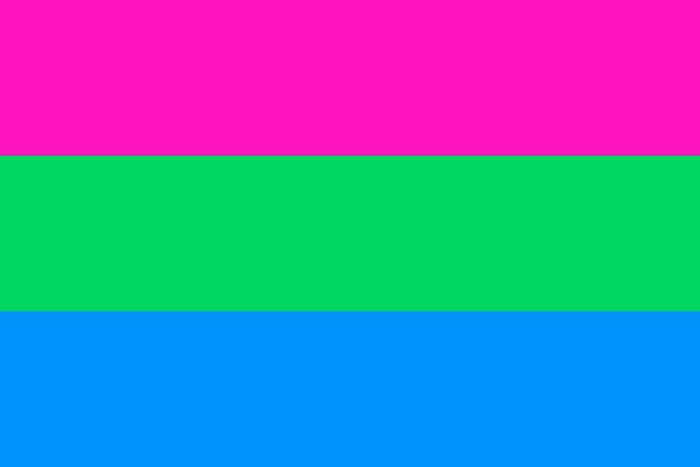
Polysexual Pride Flag
Polysexual people—who are sexually attracted to multiple, but not all, genders—got their own flag in 2012. The LGBTQ flag was designed by a Tumblr user with the signature “Samlin.” Both the colors and the design borrowed from the Bisexual and Pansexual flags. The blue and pink represent attraction to those who identify as male and female, respectively, and the green represents attraction to people who identify outside the traditional male-female binary.
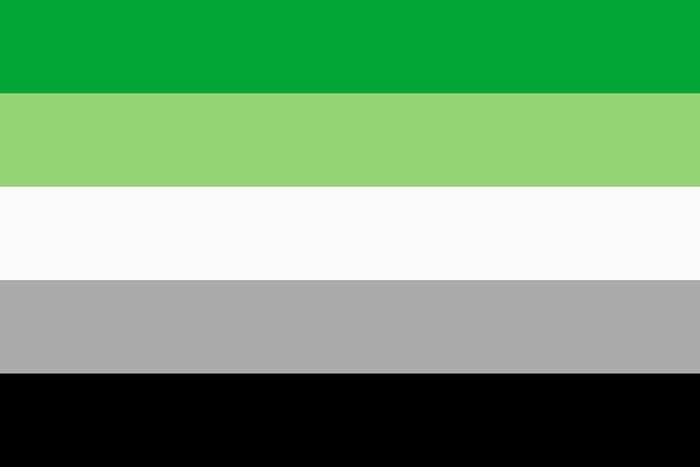
Aromantic Pride Flag
The Aromantic Pride Flag represents people who either do not experience romantic attraction or do so in a nontraditional way. There were two earlier versions of this flag; it’s unclear when the first was created, but both the second and the current version were designed in 2014. The color green represents aromanticism, and it appears in two shades on the flag, along with white (for platonic and aesthetic attraction), gray (for gray-aromantic and demiromantic people) and black (for the sexuality spectrum).
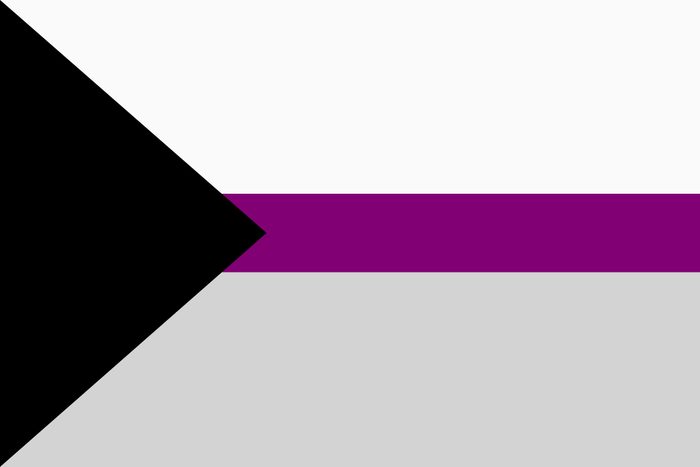
Demisexual Pride Flag
The Demisexual Pride Flag represents a section of the asexual community that develops sexual attraction to someone only after forming a deep emotional bond with them. It’s unknown when, exactly, the flag was created, but it includes four colors: black (representing asexuality), gray (asexuality and demisexuality), white (sexuality) and purple (community).
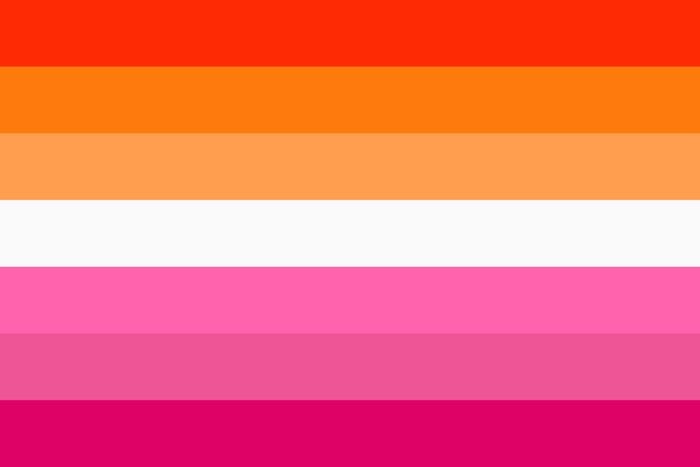
Lesbian Pride Flag
There are multiple versions of the Lesbian Pride Flag, and you’ve probably seen some of them in LGBTQ shows and movies. But this one—which has been around since 2018—appears to be the one that’s most widely embraced. The seven different shades of pink, orange, white and red were used to represent different types of femininity.
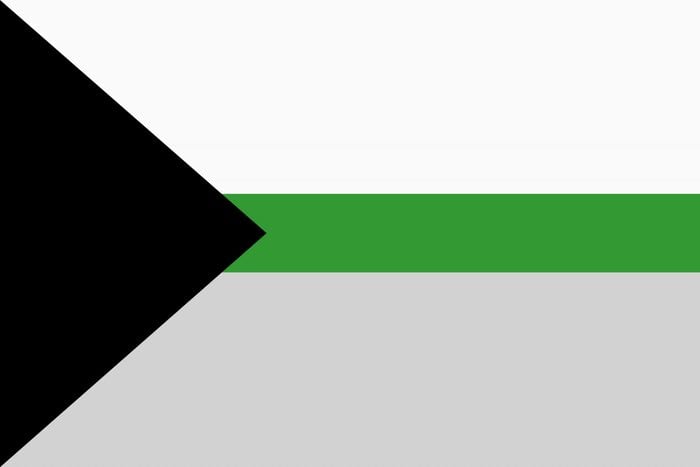
Demiromantic Pride Flag
Often grouped under the asexual umbrella, demiromantic individuals only become romantically attracted to someone after forming an emotional bond with them. The origins of the Demiromantic Pride Flag are unknown, but the Asexual Visibility and Education Network has included information on the demiromantic identity on its website since 2011.
The design might look a little familiar. That’s because it’s similar to the Demisexual Pride Flag—white top half, gray bottom half and black triangle to the left—with one key difference: The stripe between the halves is green. It’s believed the colors each hold a special meaning:
- Black: Sexuality spectrum
- Grey: Gray-aromanticism and demiromanticism
- White: Platonic and aesthetic attraction as well as queer/quasi-platonic relationships
- Green: Aromantic spectrum
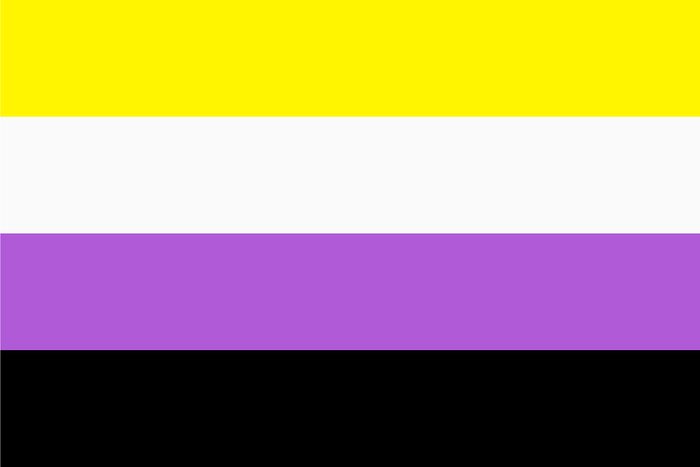
Nonbinary Pride Flag
This LGBTQ flag was created in 2014 to represent nonbinary people, whose gender identity does not fit within the traditional male/female binary. The goal wasn’t to replace the Genderqueer Pride Flag but to fly the Nonbinary Pride Flag alongside it. Its colors symbolize those whose gender falls outside of and without reference to the binary (yellow), people with many or all genders (white), those whose gender identity falls somewhere between male/female or is a mix of them (purple) and people who feel they are without a gender (black).
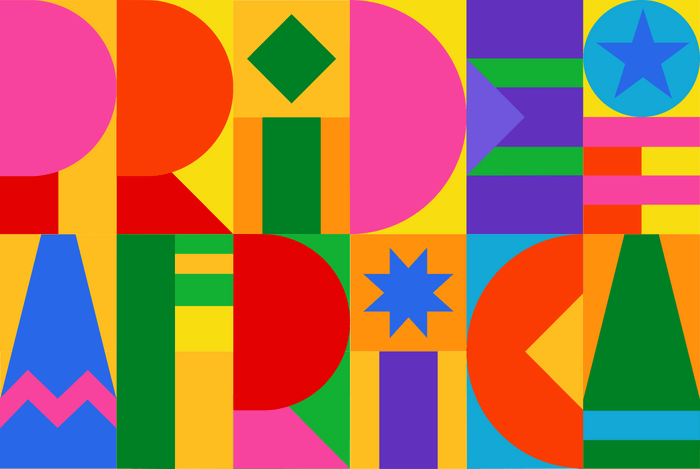
Pride of Africa Flag
In 2019, Pride of Africa, which describes itself as a “diversity and empowerment foundation,” launched a new LGBTQ flag at Johannesburg Pride, the continent’s longest-running LGBTQ Pride event. Considered the first pan-African LGBTQ flag, the Pride of Africa Flag was inspired by the flags of all 54 countries on the continent.
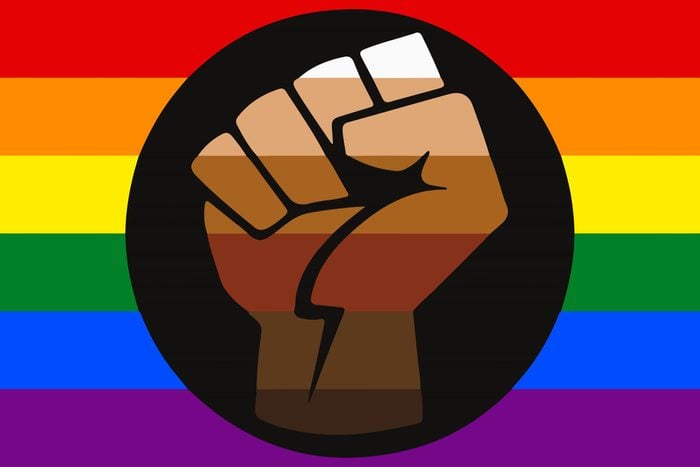
Queer People of Color Pride Flag
Although the flag’s designer and year of creation are unknown, the Queer People of Color (QPOC) Pride Flag made an appearance at San Francisco Pride in 2019 and rose to prominence in 2020. The raised clenched fist in the center of the traditional rainbow flag indicates solidarity with the Black Lives Matter movement. The QPOC flag also represents how intertwined the queer community and people of color have been over the years in their fight for equality, including in the early days of the queer liberation movement and the work of activist Marsha P. Johnson.
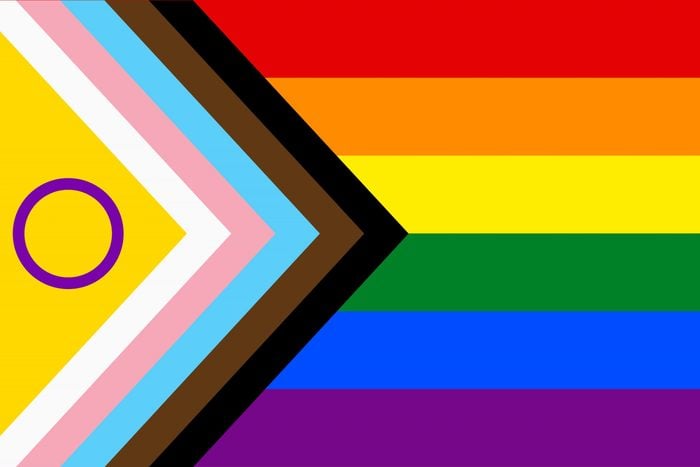
Intersex-Inclusive Pride Flag
Over the years, the rainbow LGBTQ flag has evolved to become increasingly inclusive. One of the most recent updates came in 2021, when Valentino Vecchietti of Intersex Equality Rights UK added a yellow triangle with a purple circle—the design of the Intersex Pride Flag—to the Progress Pride Flag.

Trans-Inclusive Gay Men’s Pride Flag
This is the second iteration of the Gay Men’s Pride Flag, and it includes green, blue and purple colors. The original version featured only shades of blue, and it was seen as excluding non-cisgender gay men, including those who are transgender, intersex and gender nonconforming.
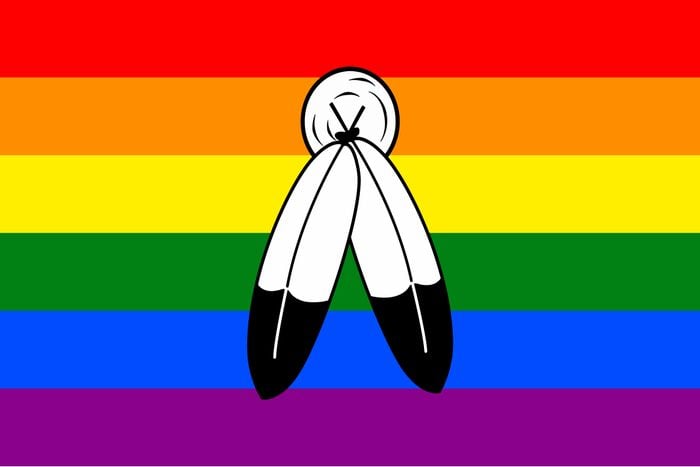
Two-Spirit Pride Flag
Some Indigenous Americans identify as two-spirit individuals, meaning they fall outside the male-female binary, and this can be used to describe a person’s sexual, gender and/or spiritual identity. Though it’s not clear when it was first designed, the Two-Spirit Pride Flag uses two feathers to represent masculine and feminine identities. The circle symbolizes the unification of masculine and feminine identities into a separate gender, and the rainbow of colors represents modern LGBTQ identities.
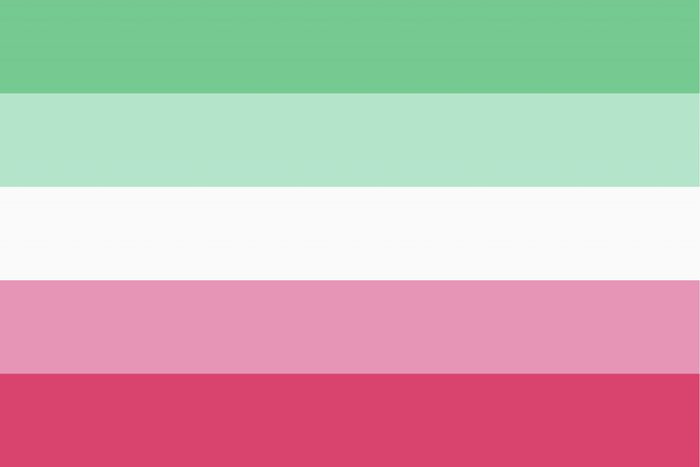
Abrosexual Pride Flag
The Abrosexual Pride Flag represents those who identify as abrosexual—that is, people whose sexual identity is fluid and whose sexual orientation fluctuates over time. It was created by Tumblr user Mod Chad after someone requested it, but it’s thought to have originated on DeviantArt in 2013. It contains five colors, though their meanings are unknown. From top to bottom, they are:
- Dark green
- Light green
- White
- Pale pink
- Magenta
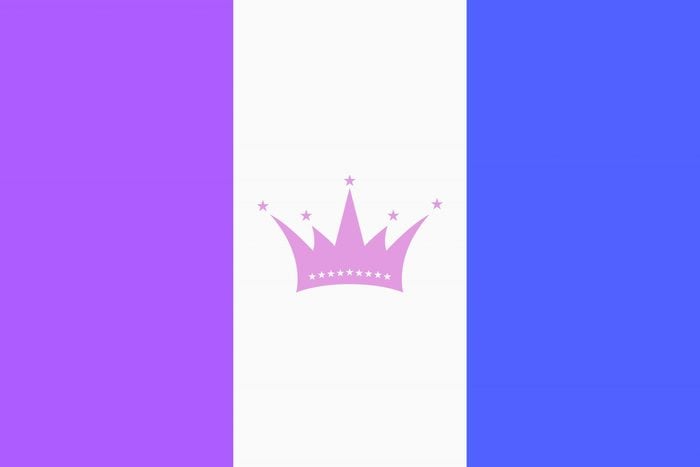
Drag Pride Flag
Although there was an earlier version of the Drag Pride Flag created by artist Sean Campbell in 1999, it was originally known as the Feather Pride Flag. Fifteen years later, Veranda L’Ni, a drag performer from Cleveland, Ohio, created this second iteration of the Drag Pride Flag—the one most commonly used now. The LGBTQ flag made its debut at the 2016 Austin International Drag Festival and features a crown and stars on three vertical stripes, each of which has a meaning:
- Purple: A passion for drag
- White: The blank slate a face and body become when creating drag characters
- Blue: Self-expression and loyalty
- Crown: Leadership within the community
- Stars: The many forms of drag
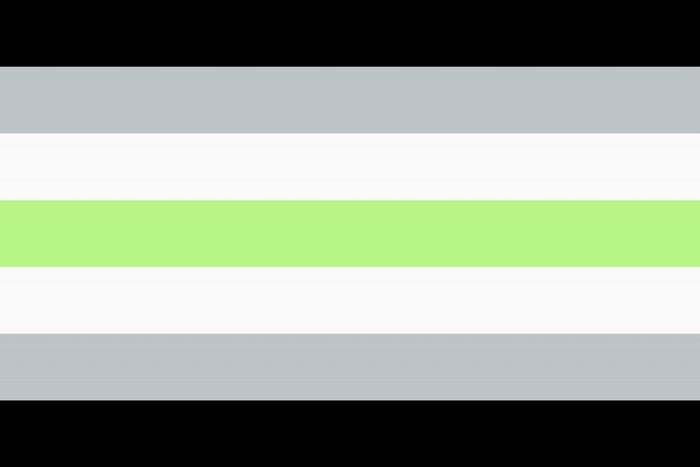
Agender Pride Flag
Created in 2014 by New York–based artist and activist Salem X, the Agender Pride Flag represents people who identify as having no gender, an unidentifiable gender, or being gender neutral. There are a total of seven stripes: two black, two gray, two white and one green, and each color has its own meaning.
- Black: The absence of gender
- White: The absence of gender
- Gray: Semi-genderless
- Green: Nonbinary genders
Why trust us
At Reader’s Digest, we’re committed to producing high-quality content by writers with expertise and experience in their field in consultation with relevant, qualified experts. We rely on reputable primary sources, including government and professional organizations and academic institutions as well as our writers’ personal experience where appropriate. We verify all facts and data, back them with credible sourcing, and revisit them over time to ensure they remain accurate and up to date. Read more about our team, our contributors and our editorial policies.
Sources:
- University of Northern Colorado: “Pride Flags”
- Pride.com: “The Complete Guide to Every Queer Pride Flag”
- TriPride: “Pride Flags”
